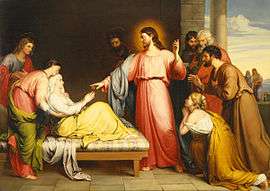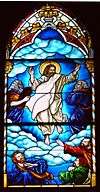Healing the mother of Peter's wife
The healing of the mother of Peter's wife is one of the miracles of Jesus in the Gospels, reported in Matthew 8:14–15, Mark 1:29–31, and Luke 4:38–39.[1]

Narrative
In the Gospels of Mark and Luke, this episode takes place after Jesus had been preaching at the synagogue of Capernaum. Jesus goes to Peter's house, where he sees the mother of Peter's wife lying in bed with a high fever. Jesus touches her hand and the fever leaves her, and she gets up and begins to wait on him. In Matthew's gospel the event is the third in a series of healings recorded in chapter 8 which take place following Jesus' Sermon on the Mount.
Commentary
Peter's wife’s mother was sick with fever. In the Talmud, fever is described as a fire.[2] The original Greek implies that she was seriously ill.[3] Those present mention her illness to Jesus. He walked over to her, took her hand, and helped her up. Then the fever left her and she waited on them.
Silas Henderson notes that in Mark's gospel, the Greek word translated as "helped her up" is the same used later in Mark 16:6 by the angel at the tomb when he tells the women that Jesus "has been raised". Henderson views this as Mark making a connection to the Resurrection, suggesting that a women grievously ill has been restored to new life demonstrated by service to others.[3]
In the majority of readings of Matthew 8:15, she began to wait upon "him" (i.e. Jesus) but in the Textus Receptus she began to wait upon "them" (Greek: αὐτοῖς, autois). Mark and Luke both refer to "them"; Johann Bengel therefore argues that in Matthew's gospel, "him" is the correct reading and "them" is an "erroneous reading ... introduced from the other Evangelists".[4]
Following this event, the Gospels report that at sunset, "the people brought to Jesus all who had various kinds of sickness or were demon-possessed, and laying his hands on each one, Jesus healed them and cast demons out of them" (Matthew 8:16–18).
Biblical commentator Matthew Henry used the incident to argue that "Christ ... showed that he approved of the married state, by being thus kind to Peter's wife's relations".[5]
References
| Wikimedia Commons has media related to Healing Peter's Mother-in-Law. |
- John Clowes, 1817 The Miracles of Jesus Christ, published by J. Gleave, Manchester, UK page 31
- van der Loos, Dr. Hendrik (1965). The Miracles of Jesus. E.J. Brill, Leiden, Netherlands. pp. 552–555.
- Henderson S.D.S., Silas. "How the story of Peter’s mother-in-law is actually about us", Aleteia, February 3, 2018
- Bengel's Gnomon of the New Testament on Matthew 8, accessed 23 December 2016
- Matthew Henry's Commentary on Matthew 8, accessed 23 December 2016
